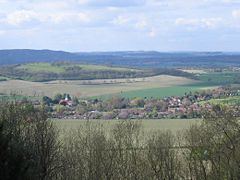Population 1,451. 2011Census Civil parish Harting Area 32.16 km² Dialling code 01730 | OS grid reference SU786215 Sovereign state United Kingdom Local time Friday 12:46 PM | |
 | ||
Weather 9°C, Wind W at 21 km/h, 65% Humidity | ||
Harting is a civil parish in the Chichester District of West Sussex, England, situated on northern flank of the South Downs 3.5 miles south east of Petersfield. It comprises four settlements namely Nyewood plus South, East and West Harting.
Contents
Map of Harting, UK
The village of South Harting is the largest settlement. It has two churches, one Anglican and one Congregational, and a school, Harting Church of England Primary School, which takes children from four to eleven years old. Alongside the school is the village hall from which a pre-school group operate.
In 2001 the parish covered 3,216 hectares (7,944 acres) and had 616 households with a total population of 1,407. 646 residents were economically active. At the 2011 Census the population had increased to 1,451.
History
Harting is mentioned in the Domesday Book as the Manor of Hertinges. Apart from three generations of the Earls Montgomery the manor was in the possession of the Crown until 1610 when it was granted to the Caryll family. In 1746 the manor was purchased by the Featherstonhaugh /ˈfænʃɔː/ family, in whose possession it remains.
Harting Down
The villages are overlooked by Harting Down, a 550-acre (2.2 km2) common owned by the National Trust and part of the Sussex Downs Area of Outstanding Natural Beauty. Rising to 229 metres (751 ft), it offers panoramic views over the Weald to the north, to the English Channel and the Isle of Wight to the south.
Archaeological evidence has suggested that Harting Down was first occupied around 5000 years ago. Neighbouring Beacon Hill is home to a hillfort from the Iron Age, built around 500 BC as an animal enclosure and refuge. In addition, a cross ridge dyke was built around the same time, may have been used to control movement of people and animals along the ridgeway.
Because of its elevation Beacon Hill, just to the east of Harting Down, hosted a station in the shutter telegraph chain, from 1796 to 1816, which connected the Admiralty in London to its naval ships in Portsmouth and Plymouth. This was replaced in 1822 by a semaphore station which operated on a slightly different route until 1847. Bertrand Russell and his wife Dora founded the experimental Beacon Hill School at Telegraph House, which was their residence in 1927.
West of Beacon Hill is Tower hill, on top of which is the Vandalian tower, a folly dating to the 18th century which is in the grounds of Uppark house. It was built to celebrate the founding of the American colony of Vandalia in 1774, though the events of the American Revolution meant that the colony never got off the ground. The tower is in ruins and cannot be entered, but can be seen from outside.
A large portion of the down has never been used for modern intensive farming and is thus an important site representing the chalk grassland that once covered the downs. Plants found on the site include quaking grass and the common spotted orchid. The down supports animals such as adders, skylarks and several species of butterfly.
Governance
An electoral ward in the same name exists. This ward includes surrounding parishes and has a total population taken at the 2011 census of 2,026.
